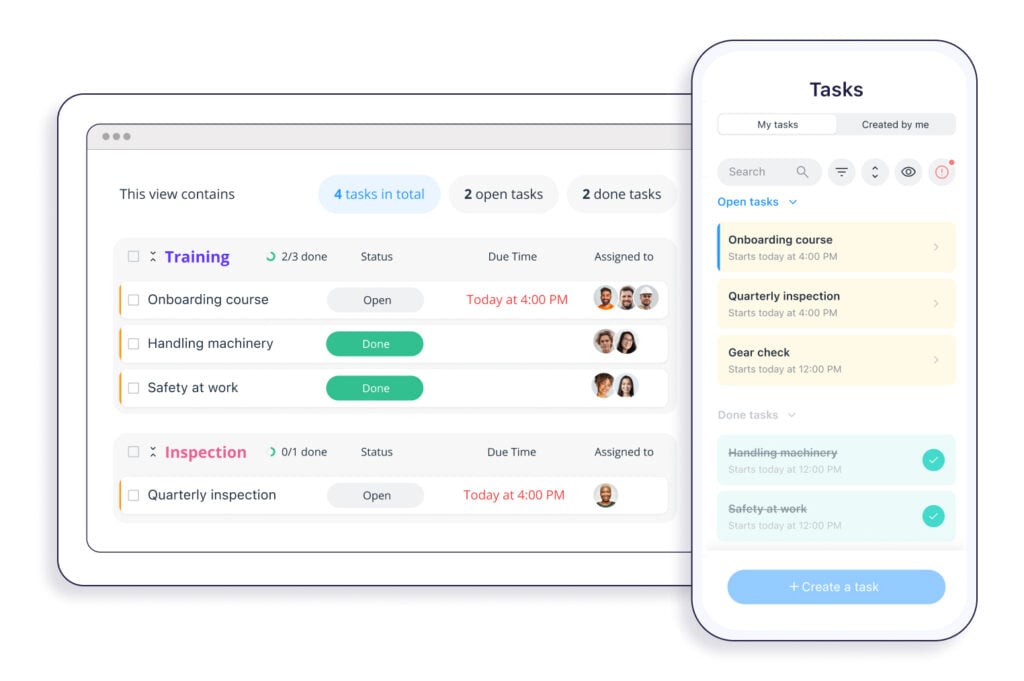Many people dream of starting or expanding a construction business, but don’t know which niche will fit their skills and goals or where the opportunities lie.
Choose the wrong sector, and you could end up in an area you don’t have the expertise to succeed in—or get stuck in a low-demand, high-competition, or unprofitable business.
Below, I break down 8 different types of construction businesses, sharing their pros, cons, and real-world examples so you can properly understand the ins and outs of each type and set yourself up for success.
Key Takeaways
- There are 8 main types of construction businesses—from popular sectors like residential and commercial to specialized sectors like renovation and remodeling.
- General and specialty contractors manage projects across various sectors and provide an easier entry point into the market.
- Niche sectors and emerging trends, like sustainable or modular builds, can offer better margins and faster growth.
Top Types of Construction Businesses
Here are the different types of construction businesses you could start or expand into.
Residential construction
These businesses build and develop homes, from single-family homes and townhouses to multi-unit apartments, condos, and even full-fledged residential communities with roads, utilities, and shared amenities. Companies range from small to medium-scale builders catering to individual homeowners to large-scale developers working for real estate investment giants.
Pros
- You can start a new construction business on a smaller scale, building individual homes locally.
- Experienced builders can use transferable skills, knowledge, and resources to expand or pivot to another project type—for instance, from single to multi-family homes—without starting from scratch.
- Even when sales are slow, completed homes are assets you can rent out temporarily and might appreciate over time.
Cons
- Economic downturns, high interest rates, and job losses can reduce demand for residential properties.
- In some big US cities, zoning rules and permit timelines can significantly delay project timelines and hamper cash flow.
- Even small-scale residential builders need significant startup capital for land deposits, tools and equipment, licenses, permits, insurance, etc.
This Might Interest You
Discover our complete guide on what it costs to start a construction company.
Real-world example
Wausau Homes: Based in Rothschild, Wisconsin, this private, regional residential construction company builds custom single-family homes from scratch across several Midwest states.
Commercial construction
Commercial construction involves building spaces for business use. Businesses range from small firms focusing on small to medium-sized offices, retail stores, cafes, and restaurants to larger developers constructing multi-million dollar corporate headquarters, malls, luxury hotels, and mixed-use developments.
Companies might build from the ground-up or specialize in quick-turn fit-outs—for example, turning an empty retail unit into a fully branded coffee shop in a few weeks.
Pros
- You can specialize in a niche, such as restaurants or medical offices, to stand out in a crowded market and charge premium rates.
- There are bigger payouts per project, as commercial contracts are typically larger than residential jobs.
- Commercial buildings often require ongoing maintenance, renovations, or expansions, which creates opportunities for more business.
Cons
- Entry barriers are higher, as you’ll need to invest high capital and network to land larger contracts.
- There are additional regulatory requirements, inspections, etc., especially in niches with health and safety implications.
- Specific sectors like office spaces, cinemas, and restaurants face a mild threat from digital shifts like remote work, online streaming platforms, and food delivery businesses.
Real-world example
Flintrock Commercial: From Austin, Texas, this regional construction company’s primary focus is building small to medium-sized commercial buildings and tenant finish-outs in Austin and the surrounding areas.
Industrial construction
This type of construction covers manufacturing plants, warehouses, distribution centers, or any supply chain and logistics facilities. It involves various companies, from those that build small warehouses or food processing plants to those constructing massive oil refineries and power plants.
Pros
- Involved large-scale contracts bring in significant revenue once secured.
- Work is tied to essential industries like energy, logistics, or food production that are more stable than consumer-driven markets like residential or commercial.
- Industrial leases often span several years, which means predictable income for developers who rent their facilities out.
Cons
- Contractors often require advanced technical knowledge, strict safety compliance, and specialized equipment to operate in this sector.
- Barriers to entry are high for new firms, as clients prefer experienced businesses with proven track records.
- Large footprints, specialized equipment, and heavy-duty materials push the initial capital requirement to much higher levels than residential and commercial sectors.
Real-world example
PCL Construction: A leading North American construction firm that covers a range of services, including building advanced manufacturing facilities, like semiconductor facilities.
Public works construction (infrastructure or institutional buildings)
This category covers large-scale projects intended for public and community use—including physical networks such as roads, bridges, tunnels, airports, and transportation systems, and service-oriented facilities like schools, hospitals, museums, and government buildings. Projects are usually funded by local, state, or federal governments or through public-private partnerships.
Pros
- Projects provide steady demand and a strong funding pipeline, as essential infrastructure and public facilities are always in need of building, upgrading, or maintaining.
- Projects are typically high-value and long-term, yielding predictable cash flow for multiple years once secured.
- Multiple building and development types offer these businesses the chance to diversify or specialize.
Cons
- Public and institutional projects often attract many qualified bidders, driving down price points and, therefore, profit margins.
- Timelines for approvals can take years, delaying projects and disrupting cash flow.
- Securing public contracts requires several formal steps, such as prequalification, bonding (surety from the construction firm to the client that they’ll complete the project), and proof of compliance with safety, environmental, and labor regulations.
Did You Know?
You can use Connecteam’s free digital forms and checklists to ensure workers complete site inspections, safety checks, and more. This way, you’re compliant with safety regulations and can prove it with thorough documentation.
Real-world example
McCarthy: This employee-owned contractor works on projects across the US, including heavy civil works like roads, bridges, and rail, as well as marine infrastructure, such as ports, terminals, and wharves.
Renovation and remodeling
These small to medium-sized businesses look at improving, updating, or altering existing structures rather than building from scratch. They focus on specific sectors or cover anything from kitchen and bathroom upgrades to full-home makeovers, commercial space refreshes, or restoring historical buildings like museums or statues.
Pros
- New entrants find it much easier to penetrate the construction market this way rather than building from scratch.
- Projects often need low initial capital and few tools.
- There’s steady demand for upgrading or refreshing existing buildings rather than starting from scratch.
Cons
- Working in occupied spaces can slow progress and create logistical challenges that can be frustrating.
- Managing client expectations requires patience and strong communication skills, as the scope of work can often change mid-project.
- Projects often come with hidden surprises like structural issues or water damage that can blow budgets and delay timelines.
Pro Tip
Good task management tools, such as Connecteam’s employee task tracking, let you assign tasks to workers and even add images and videos so they know exactly what needs to be fixed and how. This is great for keeping projects on track.
Real-world example
Rise Construction (formerly Musk Construction): A medium-sized residential contractor in the San Francisco Bay Area, specializing in kitchen and bathroom remodeling and renovations.

General and specialty contracting
General contractors oversee entire construction projects across 1 or more sectors, handling all phases—for instance, building an entire office building from foundation to finish. They source materials, hire and manage subcontractors, ensure compliance, and keep the project on track.
Specialty contractors focus on a specific trade in the construction world—plumbing, roofing, HVAC installations, electrical work, concrete work, and so on.
Both can operate as small, medium, or large businesses, depending on the projects they undertake.
Pros
- General contractors can take on a wide variety of projects, spreading risk during slow periods for specific sectors.
- Specialization reduces competition while helping specialty contractors market construction services better and charge premium pricing.
- Both types of contracting offer easier entry points for newbies, enabling them to get clients—with no experience or networking—through online apps like TaskRabbit.
Cons
- General contractors face higher liability risks since they’re in charge of every aspect of a project.
- General contractors might also face intense competition, especially in saturated markets.
- Specialty contractors can experience project delays and cash flow choke-ups if earlier phases aren’t completed in time.
Real-world example
Illuminate Electrical: This Louisiana-based family-owned residential and commercial electrical contractor offers a range of electrical services for new construction and remodels, including generator installation, lighting design, home automation, and security systems.
Green and sustainable construction
These businesses specialize in designing and building projects that boost long-term energy efficiency and minimize environmental impact by using eco-friendly materials, water-saving technologies, renewable energy systems, and more.
Companies typically work on anything from constructing homes with ultra-low energy requirements to building LEED Platinum-certified community centers with sustainable landscaping, or even fitting establishments with solar panels, rainwater harvesting systems, and energy-efficient HVAC systems.
Pros
- Demand for these projects is growing as more businesses, governments, and homeowners prioritize sustainability and energy efficiency.
- Specialized expertise and certifications in green building—for instance, LEED—command higher rates.
- Long-term cost-saving potential attracts both active and passive clients, making it easier to market your services.
Cons
- Initial costs for eco-friendly materials and sustainable processes can be high.
- Certification processes can be time-consuming and require meticulous paperwork.
- Workers need ongoing education and training to stay current with green building technologies and regulations.
Did You Know?
Connecteam’s employee training app lets you build custom training modules from scratch—a great way to educate team members on the latest construction practices. You can even use built-in AI to turn simple prompts into full-fledged courses.
Real-world example
Skanska: This national commercial and infrastructure contractor is known for sustainable building practices and delivering high-performance, efficient buildings that minimize environmental impact.
Modular and pre-fabricated construction
This type of construction involves manufacturing building components, such as walls, floors, or entire rooms, in a factory setting and transporting finished pieces to job sites for assembly. Modular and pre-fab construction companies typically work on residential, commercial, or institutional projects—for example, building pre-fabricated tiny homes and backyard studios or delivering fully finished rooms that are ready to stack and connect on-site.
Pros
- This construction type speeds up construction timelines significantly—leading to happier clients and more projects.
- Lower labor costs and less wastage are big selling points for clients and boost profit margins.
- Better quality control through standardization in factory-controlled environments reduces rework and delays.
Cons
- The upfront capital required to build or buy manufacturing facilities can be substantial.
- Modules and parts face a significant risk of damage without careful transportation logistics.
- There’s limited design flexibility and customization options compared to on-site builds.
Real-world example
Hapi Homes: This modern modular residential builder delivers panelized tiny homes, hospitality units, and emergency housing.
How To Choose the Right Construction Business Model
Consider these factors when choosing from the different types of construction businesses.
| Factors | Considerations |
| Skills and expertise | What are your technical strengths, trade specializations, and management abilities? Brian Morton, founder of My Window & Door Guy, says, “It was easy for us to choose window and door replacements because that’s the experience we had. My advice for those mulling their options is to pick a specialty that they have expertise in… Customers want to hire experts.” |
| Capital requirements | Some sectors, like industrial or large-scale commercial, need heavy upfront funding, while others, like renovations or specialty contracting, can start smaller. What can you afford? |
| Market demand | Which construction services are growing in your area, and what are the trends? For instance, industrial construction could be a good choice in a city seeing a surge in logistics centers. Avoid entering an oversaturated or declining market. |
| Local regulations | Can you withstand delays due to local zoning restrictions, building codes, and permitting timelines in dense urban locations? If not, you could consider a different construction type or more rural locations. |
| Licenses and certifications | Consider the need for additional qualifications in specialized construction work, such as electrical, plumbing, or green building. Do you have or can you get those qualifications? |
| Risk tolerance | Compared with smaller projects, larger projects tend to be high reward but also face higher risks from longer timelines, bigger liabilities, and exposure to market swings. How much risk can you take on? |
The 4 main types of construction include residential, commercial, industrial, and infrastructure construction, though many companies specialize in other areas such as institutional and green construction.
The most profitable type of construction business depends on market demand, location, and specialization. Big projects in large-scale commercial, industrial, or infrastructure sectors tend to have high construction profits due to higher revenue. Meanwhile, niche areas like modular construction can command high rates and reduce bottom-line labor costs.
The easiest construction business to start is renovation and remodeling—for instance, of kitchens, bathrooms, and other home upgrades. It’s less capital-intensive, can be done on a smaller scale, and lets you enter the market and build a client base quickly.


